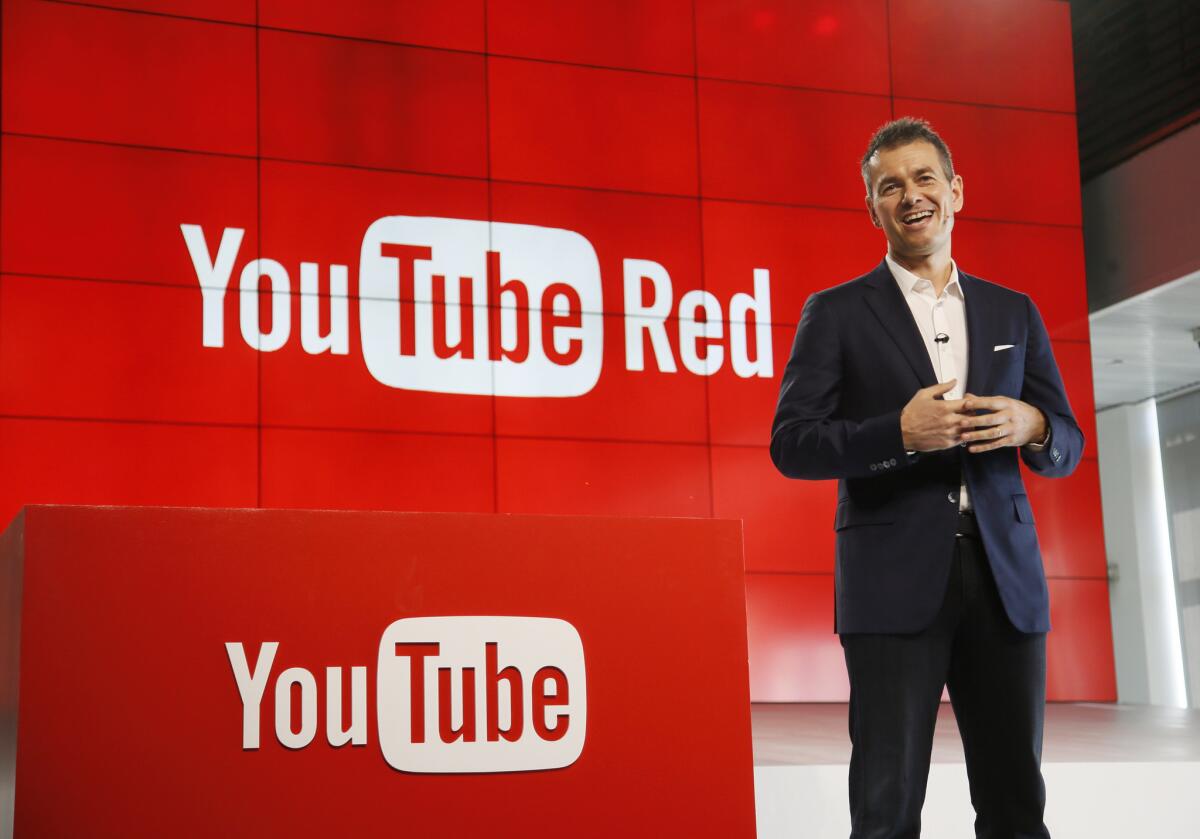YouTube said to be planning paid streaming TV service

YouTube launched a subscription service last year called Red that charges $9.99 a month for an ad-free experience, access to Google Play music and a host of original content built around the company’s stable of young stars like PewDiePie. Above, Robert Kyncl, YouTube chief business officer, at unveiling of the service.
- Share via
When YouTube debuted a decade ago, it quickly built an audience by hosting pirated material — much to the chagrin of the nation’s biggest TV and cable networks.
Now YouTube is reportedly in talks with those same networks to stream TV through a paid service called Unplugged that could serve as a Web-based alternative to the cable box.
The news, first reported by Bloomberg on Wednesday, comes on the same day that Hulu said it would soon offer a so-called skinny bundle of broadcast and cable TV channels.
The moves highlight the massive shift taking place in the TV industry as networks seek to stanch the flow of cord cutters by looking at former adversaries in the tech world to help recapture audiences, particularly younger ones.
YouTube, which is owned by Google parent Alphabet Inc., is talking to major media companies, including Comcast Corp.’s NBCUniversal, Viacom Inc., 21st Century Fox Inc. and CBS Corp., according to Bloomberg, citing anonymous sources.
A YouTube spokeswoman said the company does not comment on “rumor or speculation.”
The plan, which has reportedly been in the works since 2012, would package the four major TV networks with a smattering of cable offerings. Another option would provide thematic packages, such as comedy or fashion channels.
Such packages, known as skinny bundles, are considered a possible solution to cable TV’s declining audiences. Unlike traditional packages that can run well over $100 a month, skinny bundles allow customers to choose smaller, customized packages of TV channels at lower prices.
YouTube wants to sell its bundles for less than $35, according to Bloomberg.
“The challenge for YouTube in pulling this off is that they have a mass audience that likes things for free,” said Eunice Shin, the Los Angeles director of Manatt Digital Media, a consulting and venture capital firm.
YouTube launched a subscription service last year called Red that charges $9.99 a month for an ad-free experience, access to Google Play music and a host of original content built around the company’s stable of young stars like PewDiePie.
Although YouTube has not disclosed how many people have signed up for Red, Google’s chief executive Sundar Pichai has said he’s pleased with the service. However, industry sources speaking on the condition of anonymity say Red has not generated the following the company had hoped it would.
Analysts say YouTube will struggle to strike a deal with TV networks over money — not unlike the way that Apple Inc. failed in its talks with networks last year to launch a skinny bundle.
“I don’t see how this is going to succeed,” said Alan Wolk, a senior analyst at Diffusion Group, a media consulting firm. “Google’s going to run into the same problems Apple did.”
In addition, Wolk thinks that the TV networks will be hesitant to hand over their audiences to YouTube knowing the platform can mine those viewers for data and choose not to share it.
“Why would they want to give all that data to Google?” Wolk said.
Cable companies and networks, however, have been exploring partnerships with so-called over-the-top services.
These deals are seen as a way to recover some of the audience they have lost to streaming video services such as Netflix and Amazon — especially younger viewers. Nielsen figures show that prime-time TV usage has dropped 24% among viewers ages 18 to 34 since the 2011-12 season.
While never mentioning YouTube, media executives have noted in their earnings calls this week that they are engaged in discussions in making their content available in over-the-top offerings.
“We talk to everybody — we listen to everybody,” CBS Chairman and Chief Executive Leslie Moonves told analysts when asked about Hulu’s new streaming service.
CBS is offering its network as a stand-alone streaming service and is hoping to drive subscribers to it by making it the exclusive home of the next “Star Trek” series. But the company’s stance on other proposals is that as the top-rated network, “any viable service is going to include us,” a spokesperson said.
James Murdoch, CEO of 21st Century Fox, which is part owner of Hulu, also acknowledged that the company is exploring new streaming options.
“We’d like to make our programming more available, not less,” he told analysts. “We’d like to take our brands and the customer experience around our brands to new entrants in the downstream distribution market, be they over-the-top or new products and services” developed by cable video programming service providers.
[email protected] | Twitter: @dhpierson
[email protected] | Twitter: @SteveBattaglio
ALSO
Hulu scores Beatles documentary from Ron Howard, renews ‘The Path,’ ‘Mindy Project’
Netflix’s new French TV series ‘Marseille’ represents a big bet on local content
Filmmaker freedom from Netflix and Amazon is ‘overrated,’ CBS CEO Leslie Moonves says








